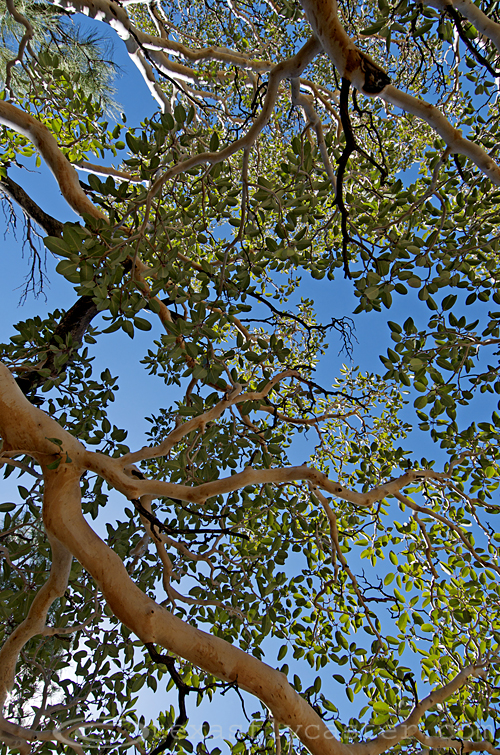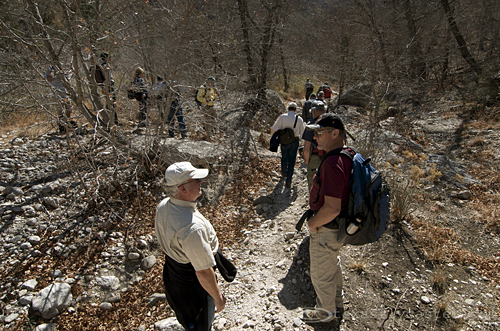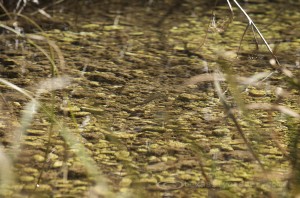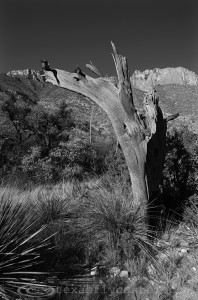A Look at Mckittrick’s Naturalized Rainbow Trout – 2
… Continued

Passing under the Madrone trees along the trail.
NPS’s Armstrong had not been through the creek since the flood, and there were places that had been changed from running water to gravel beds, and I got a little edgy when sunfish weren’t where they were, and the first potential trout spot also drew a blank.
We stopped at Prattt Cabin for lunch and to socialize a bit (catch our breath) and it was on to the next possible holding spot for McKittrick’s trout. If you do go to McKittrick, the hike to Pratt Cabin is well worth it – just by itself. It is a fascinating structure, and the stories, including the fact they were able to drive cars to that location, will confound what may be left of your feet. I was pretty certain that I wasn’t going to make it all the way to a spot where the waters are separated by a boulder shelf, and once I examined my feet while cooling in the high altitude shade around the house, I was certain I wasn’t going all the way. Blisters were beginning to float around my heels, and that hotspot you get starts to connect nerves to the brain. I adjusted, dried out, reloaded and retied my Asolo boots. They had never done this before, so I had to chalk it up to lack of activity, and that darn loose rock used on the paths. I am convinced if there had been more terra firma on the trails, even with a 30-plus pound pack I could have made the entire hike. Still, it really only rates a low-moderate at worst.

Jack Williams, head scientist for Trout Unlimited, and US Fish & Wildlife Service’s Jim Brooks talk about McKittrick’s trout habitat along the trail.

Click to enlarge.
We came to the next holding spot and there they were, tiny trout about six inches long, in ten inches of clear water over a bed of McKittrick white river rock. They were just lazily holding in the current, undulating like a flag on a breezy day. Occasionally one would slide to the left or right under power of current. As we got closer, all umpteen of us, they didn’t seem to mind too much. These ninety-year-old descendants of rainbows dumped there so long ago … had the perfect fins and coloring of any non-stocked trout, and snubby noses of nearly a century of inbreeding (as theorized by scientists on the scene). I managed a few images along the unique trout habitat, almost like an aquarium bottom, and we moved on. As interesting as these fish are in this habitat, it’s even more exciting to think of seeing Rio Grande cutthroat trout supplanting the rainbows in the future.
We found one more spot with a nice pool, maybe 9 feet in diameter, and it had the most trout we had seen, and that’s where we did the expedition’s group photo. That tiny area of water just in front of the boulder, yes right there, trout just swimming around as if nothing was happening.
It was on to the Grotto, and that’s where my feet decided to end it for me. The group went on (about another mile including some boulder hopping)without me, and I hobbled back to the trail head, slowly and unsurely. I was, at first thinking of waiting for the group to come back, but realized that would actually slow them down on their way out, so I shuffled on back to the beginning, buffeted by winds in the neighborhood of fifty miles-per-hour. McKittrick Canyon, Van Horn and the Guadalupe Mountains provide plenty to excite the imagination and camera shutter button, so if you were along for the expedition, or have something specific that may not have been seen or covered, be sure to register your question in the comments.

Check out some of the images in the book below.
[book id=’5′ /]

good stuff, i’m motivated to visit. love that B/W photo. Also, glad to be able to comment again. I went through a long period of not knowing my login but found it.
It’s one of those places that, once you go, you will want to go back again. It gets in your blood pretty quickly. The strangest part; it’s still Texas.
MAN! You are onto an AWESOME story – something unique in flyfishing/Texas/conservation. What’s the word fro the scientists as to how they would go about the re-introduction of cutts if it is deemed feasible?
The photos make me want to head out there. Who’s up for a trail running/ mountain biking/ Mexican food eating road trip next winter?!?!?